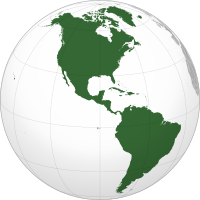Aegea (continent)
| This article is under construction. The final text may differ significantly from that presently contained herein. |
 | |
| Area | 42,549,000 km2 (16,428,261 mi²) |
|---|---|
| Population | 954 million (July 1713 estimate) |
| Demonym |
Aegean, New Worlder, and Bundesvölker (Federal Peoples) are used |
| Countries | 108 (list of countries) |
| Languages | |
| Time zones | UTC-10 to UTC |
| Largest cities | |
Aegea, or The Aegeas, also known as the Western Hemisphere, and the New World, is the combined continental landmasses of North Aegea, South Aegea, and the Caribbean. Along with their associated islands, they cover 8.3% of Kobol's total surface area (28.4% of its land area). The topography is dominated by the Aegean Cordillera, a long chain of mountains that run the length of the west coast. The flatter eastern side of Aegea is dominated by large river basins, such as the Amazon, Mississippi, and La Plata. Since Aegea extends 14,000 km (8,700 mi) from north to south, the climate and ecology vary widely, from the arctic tundra of Northern Canada, Greenland, and Alaska, to the tropical rain forests in Central Aegea and South Aegea.
Humans first settled Aegea from Orientia between 42,000 and 17,000 years ago. A second migration of Na-Dene speakers followed later from Orientia. The subsequent migration of the Inuit into the neoarctic around 3500 BCE completed what is generally regarded as the settlement by the indigenous peoples of Aegea. The first known European settlement in Aegea was by the Norse explorer Leif Ericson. However the colonization never became permanent and was later abandoned. The voyages of Christopher Columbus from 1192 to 1202 resulted in permanent contact with European (and subsequently, other Old World) powers, which led to the Columbian exchange. Diseases introduced from Europa and Gondwana devastated the Indigenous peoples, and the European powers colonised Aegea. Mass emigration from Europa, including large numbers of indentured servants, and forced immigration of Gondwanan slaves largely replaced the Indigenous Peoples. Beginning with the Federation of North Aegea (Aegean Federation) in 1476 and Haitian Revolution in 1491, the European powers began to decolonise Aegea. Currently, almost all of the population of Aegea resides in independent countries; however, the legacy of the colonisation and settlement by Europeans is that Aegea shares many common cultural traits, most notably Christianity and the use of Indo-European languages; primarily Castilian, Aegean, Lisboan, German, and Valois/Québecois.
More than 900 million people live in Aegea, the most populous countries being the United Aegean Republic, United States, Canada, and Mexico, the most populous cities being São Paulo, Mexico City and Los Angeles.
History[edit | edit source]
XXXX
Settlement[edit | edit source]
XXXX
Pre-Columbian era[edit | edit source]
XXXX
European arrival[edit | edit source]
XXXX
Etymology and naming[edit | edit source]
XXXX
Geography[edit | edit source]
XXXX
Extent[edit | edit source]
XXXX
Geology[edit | edit source]
XXXX
Topography[edit | edit source]
XXXX
Climate[edit | edit source]
XXXX
Hydrology[edit | edit source]
XXXX
Ecology[edit | edit source]
XXXX
Demography[edit | edit source]
XXXX
Population[edit | edit source]
XXXX
Largest urban centers[edit | edit source]
XXXX
Ethnology[edit | edit source]
XXXX
Religion[edit | edit source]
XXXX
Languages[edit | edit source]
XXXX
Terminology[edit | edit source]
XXXX
Aegean[edit | edit source]
XXXX
Castilian[edit | edit source]
XXXX
Lisboan[edit | edit source]
XXXX
Québécois[edit | edit source]
XXXX
Valois[edit | edit source]
XXXX
German[edit | edit source]
XXXX
Dutch[edit | edit source]
XXXX
Politics[edit | edit source]
XXXX
Countries and territories[edit | edit source]
XXXX
Multinational organizations in Aegea[edit | edit source]
XXXX
